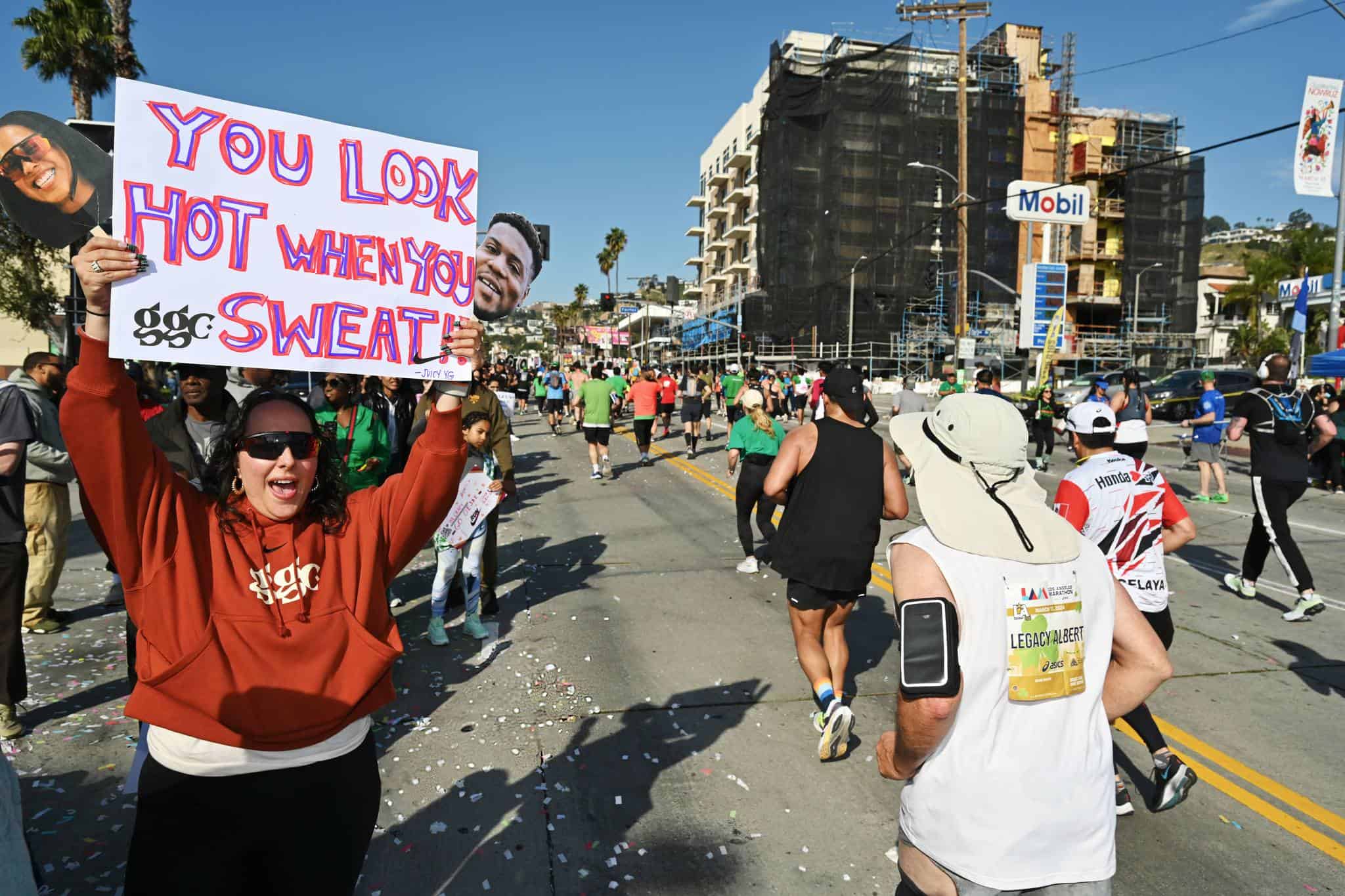If you’ve met up with anyone from Los Angeles, they’ll ask whether you got there “on the 405” or “the 10.” What they won’t ask is if there was traffic—because there’s always traffic.
The Los Angeles cityscape is overwhelmingly diverse. The downtown of the 15th tallest city in the United States is also lined with palm trees. Though usually the Los Angeles experience of the city is through the window of a vehicle in bumper to bumper traffic, the Los Angeles Marathon is in its 38th year of giving you an unparalleled intimate view at the City of Angels.

When: March 19, 2023
Runners: 20,000
Race Website: Los Angeles Marathon
Registration Fee: $189.00+
The Course
Fitting with the McCourt legacy with the Los Angeles Dodgers, the marathon begins at Dodger Stadium and finishes at Avenue of the Stars in Century City. From beginning to end, you’ll end up running through close to 20 different neighborhoods – each one with its own unique personal identity.
A little about each:
Chinatown: Built in 1938, featuring authentic pagoda-style Chinese architecture. Home to the Chinatown Gateway Monument, aka Dragon Gate, which you’ll pass at Mile 2
Olvera Street: The most historic section of downtown Los Angeles, reminiscent of quaint old Mexico.
Little Tokyo: One of three official Japantowns in the United States, lined with authentic Japanese restaurants, shopping, and arts.
Bunker Hill: Formerly affluent residences with Victorian enclaves, now home to skyscrapers and performing arts halls that attract millions annually.
Angelino Heights: The second-oldest community in Los Angeles, home to both Victorian homes and a nifty Hollywood Freeway.
Echo Park: Home of the Los Angeles film industry and the city’s most historic architecture.
Silver Lake: The neighborhood known for its progressive, creative types and the art they make.
Los Feliz: The home of Walt Disney’s first and second studios and the birthplace of Mickey Mouse.
Little Armenia: Home of Armenian cultural celebrations and traditions.
Thai Town: The largest Thai population outside of Thailand. Home to the largest Thai New Year festival in Los Angeles.
Hollywood: Famous for the Hollywood sign, Walk of Fame, Capitol Records Tower, and Dolby Theatre, which hosts the Academy Awards. Hollywood is one of the largest tourist destinations in California.
Sunset Strip: Known for its collection of restaurants, rock clubs, and nightclubs, which were notorious in the 1960s, including the Troubadour, Pandora’s Box, The London Fog, and Viper Room.
West Hollywood: Home to the most popular gay and lesbian scene in Los Angeles. Annually host to the “largest street party in the world” with the West Hollywood Halloween Carnaval.
Beverly Hills: Home to Bel Air, the Holmby Hills, and Rodeo Drive and world renowned for its glamorous shopping.
Century City: The small business district for many show business law firms and studios.
Westwood: A shopping village with a small-town atmosphere.
Veterans’ Administration: The sprawling VA health care campus that features the Wadsworth Chapel, a Catholic-Protestant dual chapel.
Brentwood: One of Los Angeles’s wealthiest neighborhoods and home to celebrities and luxury shopping.
Registration: Los Angeles Marathon

The Los Angeles Marathon Experience
The Los Angeles Marathon is meticulously curated for the runner’s experience.
On Friday and Saturday before the race, the Los Angeles Marathon hosts a Health & Fitness Expo at Dodger Stadium. If you haven’t attended a pre-race Expo before, this one sets a high bar. The Expo features over 50 exhibitors where you’ll be able to check out brand new fitness gear, shoe brands, dynamic photo opportunities, and live entertainment.
With mile-by-mile entertainment, back-of-the-pack party pacers, and a finish festival the race puts its best foot forward to make this experience one where both running and finishing are a celebration.
During the beginning of the race you’ll experience the most significant elevation change – from 564 feet by Dodger Stadium to 265 feet (a 300 foot drop) in the first three miles of the course. At mile four in Downtown Los Angeles, you’ll pick up 200 feet of gain and at mile fourteen you’ll lose all that altitude, but the remainder of the race has more gentle elevation change. The roads of the course are especially wide and the turns aren’t sharp which make it a favorable run on your legs and your finishing time.
If you have enough energy after the 26.2 miles, the Finish Festival comes complete with live entertainment, a beer garden, recovery station complete with massages, plenty of photo ops, and medal engraving to commemorate the occasion.
The History of the Los Angeles Marathon
The race is produced by The McCourt Foundation. The McCourt Foundation has been dedicated to enhancing the lives of patients and families affected by health-challenges within the neurology community and beyond since 1992. Over $6.3M has been donated to support research focused on Alzheimer’s, ALS, MS and Parkinson’s Diseases, with much of that research being collaborative across multiple disease states.
Registration Link: Los Angeles Marathon
By running the Los Angeles Marathon, you’re not only doing serious damage to your feet: you’re also contributing to building a healthier world.
If you’re not ready to commit to the full marathon, you can still participate through the Charity Half Marathon as part of Team TMF.
For an even shorter distance, there’s the LA Big 5K and Kids Run on the Saturday of Marathon Weekend which hosts a family-friendly run that starts and finishes at Dodger Stadium.





